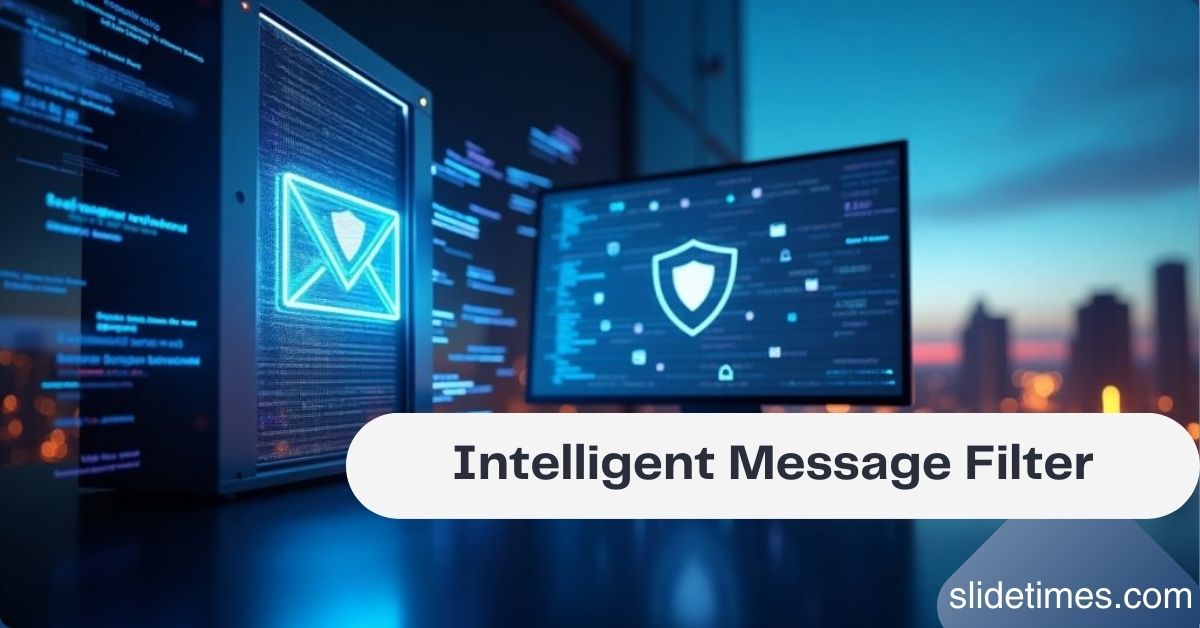In the digital age, email communication plays a vital role in both personal and professional environments. However, with the rise of email usage, spam emails, phishing attacks, and other malicious threats have become increasingly prevalent. To combat these issues, organizations use anti-spam solutions like Intelligent Message Filter (IMF). In this article, we will delve into the Intelligent Message Filter (IMF), its functionality, benefits, and how it enhances email security for users.
By the end of this article, you will have a clear understanding of how IMF works, why it is essential for email systems, and how to optimize it for better email management.
What is an Intelligent Message Filter (IMF)?
An Intelligent Message Filter (IMF) is an anti-spam filter used to check and evaluate incoming emails on Microsoft Exchange servers. IMF uses sophisticated algorithms to classify emails based on their likelihood of being spam. Each email is given a Spam Confidence Level (SCL) score, which indicates the probability of the message being spam.

The IMF evaluates multiple parameters such as message headers, sender reputation, email content, and known patterns from previous spam messages to determine the SCL score. Emails with a higher SCL are more likely to be flagged as spam, allowing administrators to take appropriate actions like blocking or moving these messages to the spam folder.
How Does the Intelligent Message Filter Work?
The core functionality of IMF is based on its ability to analyze incoming emails and assign a Spam Confidence Level (SCL) score to each one. The higher the SCL score, the more likely the message is to be spam. Here’s how the process works:
Also Read: Hacirulfitizwa: A Holistic Approach to Wellness and Personal Growth
- Email Evaluation: IMF scans various aspects of the incoming email, including its header, content, and sender information.
- Spam Confidence Level (SCL) Assignment: Based on the evaluation, the filter assigns a numeric score, the SCL, to each email. This score typically ranges from 0 to 9, with 9 being the highest likelihood of spam.
- Message Classification: Depending on the SCL score, the message is classified into one of three categories:
- Spam: Messages with high SCL scores are flagged as spam.
- Non-Spam (Legitimate): Emails with low SCL scores are considered safe.
- Quarantined or Rejected: Messages with extremely high SCL scores may be automatically quarantined or rejected.
- Spam: Messages with high SCL scores are flagged as spam.
Key Features of an Intelligent Message Filter
- Customizable SCL Thresholds:
One of the key features of IMF is the ability to set customizable thresholds for the SCL. Email administrators can adjust the SCL scores that classify emails as spam or non-spam. This flexibility allows organizations to tailor the filter to their specific needs and reduce the risk of false positives or negatives. - Automatic and Manual Actions:
IMF enables automatic actions based on the SCL score. For example, emails flagged as spam can be moved to the junk folder, deleted, or quarantined. Administrators can also manually review and classify messages, providing more control over the filtering process. - Integration with Exchange Server:
IMF is built into Microsoft Exchange Server, allowing seamless integration into existing email systems. It works in conjunction with other anti-malware and anti-spam measures to ensure comprehensive email security. - Real-Time Updates:
To ensure its effectiveness, IMF continuously updates its definitions and algorithms to keep up with emerging spam and phishing techniques. This helps maintain a high detection rate for new spam threats. - Granular Control:
Administrators have granular control over the filter settings, allowing them to create rules, whitelist or blacklist certain senders, and adjust sensitivity levels to minimize false alarms.
Benefits of Using an Intelligent Message Filter
- Reduced Spam and Phishing Attacks:
By using IMF, organizations can significantly reduce the number of spam emails and phishing attempts that reach their employees’ inboxes. This helps protect sensitive data and reduces the likelihood of security breaches. - Improved Productivity:
When employees are not constantly sifting through spam messages, their productivity improves. IMF helps ensure that only legitimate emails reach users’ inboxes, enabling them to focus on important work-related communications. - Enhanced Security:
Spam and phishing emails often carry harmful malware or links to malicious websites. By filtering these emails, IMF protects users from potential security threats that could compromise personal and organizational data. - Cost-Effective Solution:
Compared to other security solutions, IMF is cost-effective because it is built into Microsoft Exchange Server. This eliminates the need for purchasing and maintaining additional anti-spam software. - Customization and Flexibility:
With customizable SCL thresholds and filtering rules, IMF can be fine-tuned to meet the specific needs of an organization. This allows businesses to tailor the filter’s sensitivity to balance spam detection and minimize false positives.
Also Read: Zoderzinxcrose: A Revolutionary Solution in Anti-Inflammatory Treatment
How to Set Up and Configure IMF?
Setting up IMF on Microsoft Exchange Server is relatively straightforward. Here are the general steps for configuring IMF:
- Enable IMF on Exchange Server:
IMF is included with Microsoft Exchange Server, but it must be enabled in the server settings. Ensure that IMF is enabled in the Anti-Spam and Anti-Malware settings. - Configure SCL Thresholds:
Customize the SCL thresholds to define what constitutes spam. This can be done via the Exchange Management Console or the Exchange Admin Center. - Create Filtering Rules:
You can create custom rules to whitelist or blacklist certain senders, define actions for different SCL levels, and configure how emails with high SCL scores should be handled (e.g., moved to the junk folder or quarantined). - Test the Filter:
Before fully implementing IMF, test the filter with a sample of emails to ensure that it is working as expected and that the thresholds are set appropriately. - Monitor and Adjust:
After deployment, continuously monitor the filter’s performance and adjust the settings as necessary to ensure optimal performance and accuracy.
Best Practices for Using IMF Effectively
To get the most out of IMF, follow these best practices:
- Regularly Update Definitions:
Ensure that IMF’s spam definitions are up to date. This helps maintain a high level of spam detection and ensures the filter is effective against new spam techniques. - Educate Users About Spam:
While IMF is a powerful tool, educating employees about recognizing phishing attempts and avoiding suspicious email links is equally important. A combination of technical and human vigilance is the most effective way to combat email threats. - Review Quarantined Emails:
Periodically review emails that have been quarantined to ensure legitimate messages have not been mistakenly flagged as spam. Whitelist trusted senders when necessary. - Set Custom SCL Thresholds:
Customize the SCL threshold based on your organization’s specific needs. Some organizations may prefer a more aggressive filter, while others may want to reduce the chance of false positives. - Integrate IMF with Other Security Solutions:
IMF should be used alongside other security measures like anti-malware software, firewalls, and user training to provide a comprehensive defense against email threats.
Also Read: Investiit.com Tips: A Comprehensive Guide to Maximizing Your Investment Opportunities
Frequently Asked Questions (FAQs)
What is the Spam Confidence Level (SCL) in IMF?
The Spam Confidence Level (SCL) is a numeric score assigned to each incoming email to indicate the likelihood of it being spam. A higher SCL score indicates a higher likelihood of spam.
Can I customize the settings of IMF?
Yes, IMF allows administrators to customize settings such as SCL thresholds, filtering rules, and actions for handling flagged emails. This gives organizations flexibility in how they filter emails.
How does IMF protect against phishing?
IMF analyzes email content and headers to detect phishing attempts. Emails with suspicious links, forged sender addresses, or other telltale signs of phishing are flagged as spam.
Is IMF compatible with all versions of Microsoft Exchange?
IMF is available with Microsoft Exchange Server, but its features and configuration options may vary depending on the version. Ensure that you are using a compatible version of Exchange Server.
How can I improve IMF’s performance?
Regularly update the spam definitions, fine-tune the SCL thresholds, and review quarantined emails to improve IMF’s performance. Also, integrate it with other security measures for enhanced protection.
Conclusion
The Intelligent Message Filter (IMF) is a powerful and cost-effective solution for protecting organizations against spam, phishing, and other email-based threats. By automatically evaluating incoming emails and assigning a Spam Confidence Level (SCL), IMF helps organizations maintain cleaner inboxes, improve productivity, and enhance email security.
Implementing IMF, along with educating users about email security, ensures that organizations can defend against the ever-evolving threats in the email landscape. By following best practices, administrators can tailor IMF to meet their specific needs and continue to protect their users from the dangers of spam and malicious emails.
